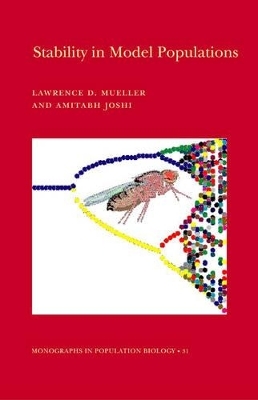
Stability in Model Populations (MPB-31)
Princeton University Press (Verlag)
978-0-691-00733-5 (ISBN)
Throughout the twentieth century, biologists investigated the mechanisms that stabilize biological populations, populations which--if unchecked by such agencies as competition and predation--should grow geometrically. How is order in nature maintained in the face of the seemingly disorderly struggle for existence? In this book, Laurence Mueller and Amitabh Joshi examine current theories of population stability and show how recent laboratory research on model populations--particularly blowflies, Tribolium, and Drosophila--contributes to our understanding of population dynamics and the evolution of stability. The authors review the general theory of population stability and critically analyze techniques for inferring whether a given population is in balance or not. They then show how rigorous empirical research can reveal both the proximal causes of stability (how populations are regulated and maintained at an equilibrium, including the relative roles of biotic and abiotic factors) and its ultimate, mostly evolutionary causes.
In the process, they describe experimental studies on model systems that address the effects of age-structure, inbreeding, resource levels, and population structure on the stability and persistence of populations. The discussion incorporates the authors' own findings on the evolution of population stability in Drosophila. They go on to relate laboratory work to studies of animals in the wild and to develop a general framework for relating the life history and ecology of a species to its population dynamics. This accessible, finely written illustration of how carefully designed experiments can improve theory will have tremendous value for all ecologists and evolutionary biologists.
Laurence D. Mueller is Professor of Ecology and Evolutionary Biology at the University of California, Irvine. He has published extensively on stability, life-history evolution, and the evolution of aging. Amitabh Joshi is a Faculty Fellow in the Evolutionary and Organismal Biology Unit of the Jawaharlal Nehru Centre for Advanced Scientific Research in Bangalore, India. His current research interests are in life-history evolution, the evolution of ecological specialization, the evolutionary genetics of circadian organization, and small population and metapopulation dynamics.
Preface and Acknowledgments vii Chapter 1 -- Introduction Historical Development of the Concept of Population Stability 7 What Is Stability? 9 Slability in Metapopulations 12 Why Are We Interested in Stability 18 Population Extinction 18 Effective Population Size 18 Fitness in Age-Structured Populations 20 Why Conduct Laboratory Experiments? 20 Laboratory Studies of Population Biology 23 Starting Populations 23 Lab Adaptation 25 Replicate Populations 26 Measuring Genetic Differences 28 Evaluating Models in Population Biology 29 General Versus Speicifc Models 31 Chapter 2 -- Theory of Population Stability 33 First-Order Nonlinear Difference and Differential Equations 34 Stability of First-Order Nonlinear Difference and Differential Equations 39 Population Cycles and Chaos 46 Cycles 46 Chaos 48 Second-and Higher-Order Models 52 Age Structure 53 Pre-Adult Density Effects on Adult Reproduction 60 Evolution of Population Stability 65 Chapter 3 -- Techniques for Assessing Population Stability 71 Linearized Population Dynamics in the Vicinity of an Equilibrium 72 Model-Based Estimates of Stability 77 Models Chosen Priori 79 Models Estiminated from Data 85 Time-Series Analysis 90 Chaos 97 Time Series 97 Detecting Chaos 99 Chapter 4 -- Blowflies 110 Life History of Lucilla cuprina in the Laboratory 111 Dynamic of Lucilia cuprina Populations 115 Modeling the Dynamics of Lucilia cuprina Populations 126 Chapter 5 -- Tribolium 132 Life History of Tribolium in the Laboratory 133 Pre-Adult Stages 134 Adult Stage 139 A Model of Tribolium Population Dynamics 143 A Model of Egg-Larva Dynamics 145 The Larva-Pupa-Adult Model 151 Empirical Evaluation of the Larva-Pupa-Adult Model 157 Chapter 6 -- Drosophila 178 Life History of Drosophila in the Laboratory 179 Larvae 180 Adults 183 A Model of Populalion Dynamics 186 Stability of Large Laboratory Populations 193 Stability of Small Laboratory Populations 196 Assessment of the Drosophila Model 208 Stability in Laboratory Metapopulations 209 Age-Structured Populations 221 Evolution of Population Dynamics 225 Increased Risk of Population Extinction with Inbreeding 230 Evolution of Population Stability 233 Chapter 7 -- Natural Populations 244 Simple Models 245 Surveys Using Reponse Surface Methods 246 Detailed Studies of Single Populations 250 Soay Sheep and Red Deer 250 Perennial Grass, Agrostis scabra 252 Lemmings and Voles 253 Red Grouse 257 Why Is Chaos Rare in Natural Populations? 259 Chapter 8 -- Conclusions 262 A Heuristic Framework for Viewing Population Dynamics and Stability 262 Lucilia cuprina, Tribolium, and Drosophila Compared 273 Model Systems in Ecology: Where Next? 280 References 287 Author Index 311 Suhject Index 316
| Erscheint lt. Verlag | 12.11.2000 |
|---|---|
| Reihe/Serie | Monographs in Population Biology |
| Zusatzinfo | 22 tables, 53 line illus., 25 halftones |
| Verlagsort | New Jersey |
| Sprache | englisch |
| Maße | 140 x 216 mm |
| Gewicht | 369 g |
| Themenwelt | Naturwissenschaften ► Biologie ► Evolution |
| Naturwissenschaften ► Biologie ► Ökologie / Naturschutz | |
| ISBN-10 | 0-691-00733-0 / 0691007330 |
| ISBN-13 | 978-0-691-00733-5 / 9780691007335 |
| Zustand | Neuware |
| Haben Sie eine Frage zum Produkt? |
aus dem Bereich


